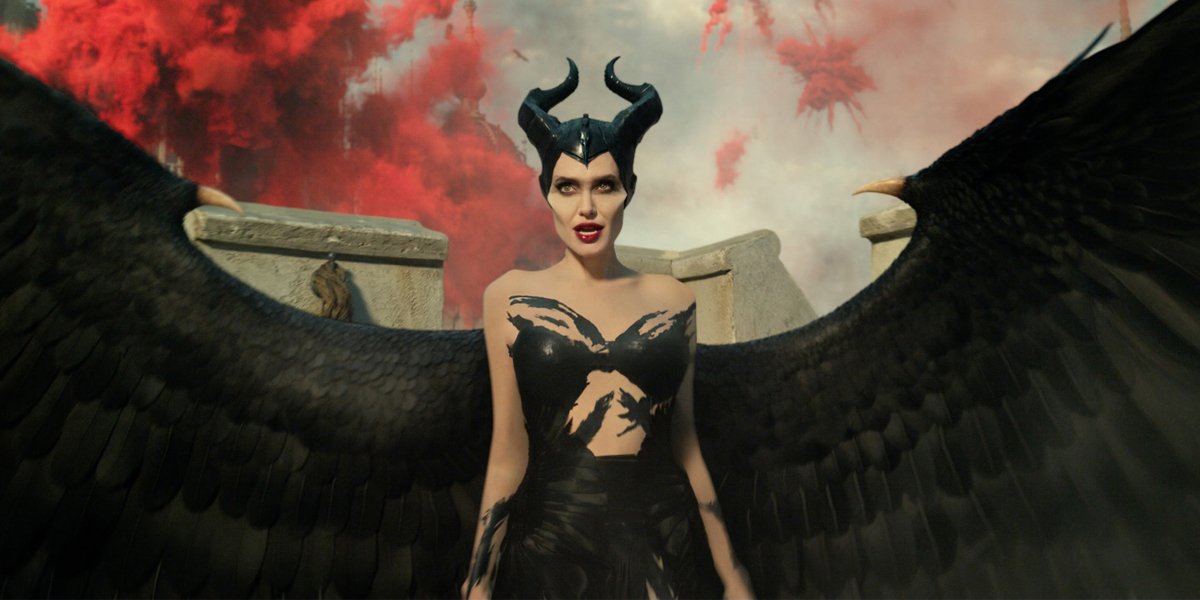When reflecting on director Robert Stromberg’s Maleficent, the two words that most quickly spring to mind are “Missed Opportunity.” The truth is that there are actually a number of good ideas packaged into the movie – from the general premise of showing a classic story from the antagonist’s perspective, to the fact that it’s basically structured as a rape revenge tale – but it gets tripped up trying to bring it all together, and it’s really just a general messiness that is the blockbuster’s downfall from a critical perspective.
What’s interesting, though, is that the failings of the first in their own way gave promise to the sequel, which has come together in the form of Joachim Ronning’s Maleficent: Mistress Of Evil. While its predecessor wasn’t able to quite stick the landing with its concepts, it did at the very least establish a modestly firm foundation from which a follow-up could grow (the follow-up being inevitable due to the fact that the original made north of $750 million worldwide).
Sadly, what we get instead is really just more of the same: missed opportunity. Once again there are some interesting concepts floated – like a magical mother vs. mother showdown, and a manipulated war between faeries and humans – but none of the material sticks together. So it’s just more meh… plus it’s also 23 minutes longer.
Scripted by Micah Fitzerman-Blue, Noah Harpster, and Linda Woolverton, Maleficent: Mistress Of Evil picks up with its central characters five years after the events of the first movie, though really not much in the world has changed. Princess Aurora (Elle Fanning) rules over the magical Moors with benevolence and grace, while her godmother, Maleficent (Angelina Jolie), continues to treat most things in the world with at the very least a mild contempt – especially those from the human world. And can you blame her?
One person she particularly doesn’t care for is Prince Phillip (Harris Dickinson), which becomes a serious problem when he gets down on bended knee and proposes to Aurora. While the faeries at large, including the watchful pixies Knotgrass (Imelda Staunton), Thistlewit (Juno Temple), Flittle (Lesley Manville), are elated by the news, the same cannot be said for Maleficent, who is driven into a rage.
Things don’t get much better, either, when a family dinner is arranged and Maleficent has the chance to meet Phillips’ mother, Queen Ingrid (Michelle Pfeiffer), who carriers extreme prejudice against magical creatures. During the meal, Ingrid is able to successfully emotionally bait Maleficent, suggesting that she can become a real mother to Aurora, and what erupts as a result is a conflict that threatens to end the world’s long reigning peace.
If you’re thinking that this is a setup to have two of Hollywood’s most gifted actresses go toe-to-toe in a big fantasy blockbuster, you’re going to be sorely disappointed. The aforementioned dinner scene is the best in the movie partially because it is one of only two in the narrative that have Maleficent and Ingrid in the same room. Their back and forth is fantastic and sharp when they are together, but the story doesn’t allow it.
Your Daily Blend of Entertainment News
Instead of letting audiences watch Jolie vs. Pfeiffer, the movie instead decides to take a left turn and decides that its more important that audiences learn that Maleficent isn’t actually the only one of her kind – but her kind is still endangered, and they are definitely pissed at humanity. It’s basically an excuse to add some noteworthy actors to the cast (Chiwetel Ejiofor and Ed Skrein), and an army with which Maleficent can do Game of Thrones-style battle with the armies of mankind.
As you can surely predict from all this, the third act is set up to be dominated by war – but it’s really all flashy, and albeit-impressive visual effects. If you really dig deep you can find a taste of subtext, and there is actually a touch of nuance present in Skrein’s character, but none of it carries any weight because all of the setup feels hollow.
With its attention focused elsewhere, the story doesn’t allow any real significant exploration of the aforementioned details that wound up being strengths of the original – namely the idea that everything we know about the classic Sleeping Beauty story has been skewed by storytellers more comfortable with the classic “prince saves princess” narrative. It would be unfair to say that the sequel totally ignores it, as it does wind up being lightly folded into the plot, but the fact that the film doesn’t explore it further is a shame, as there is a lot to dig into, and Maleficent is a rare kind of story that can pull something like that off.
Modern Hollywood has improved in the way in which it views sequels – with a surprising number of them using the opportunity to build on their predecessors rather than just repeating what people seemed to like in the first one. Maleficent: Mistress Of Evil has all the potential in the world to do just that, but it just never finds the right path forward. You can still appreciate the differing and wonderful flavors of sinister projected by both Angelina Jolie and Michelle Pfeiffer in their roles, and Elle Fanning is delightful, but it’s unfortunate that the film doesn’t give them stronger material to work with.

Eric Eisenberg is the Assistant Managing Editor at CinemaBlend. After graduating Boston University and earning a bachelor’s degree in journalism, he took a part-time job as a staff writer for CinemaBlend, and after six months was offered the opportunity to move to Los Angeles and take on a newly created West Coast Editor position. Over a decade later, he's continuing to advance his interests and expertise. In addition to conducting filmmaker interviews and contributing to the news and feature content of the site, Eric also oversees the Movie Reviews section, writes the the weekend box office report (published Sundays), and is the site's resident Stephen King expert. He has two King-related columns.

